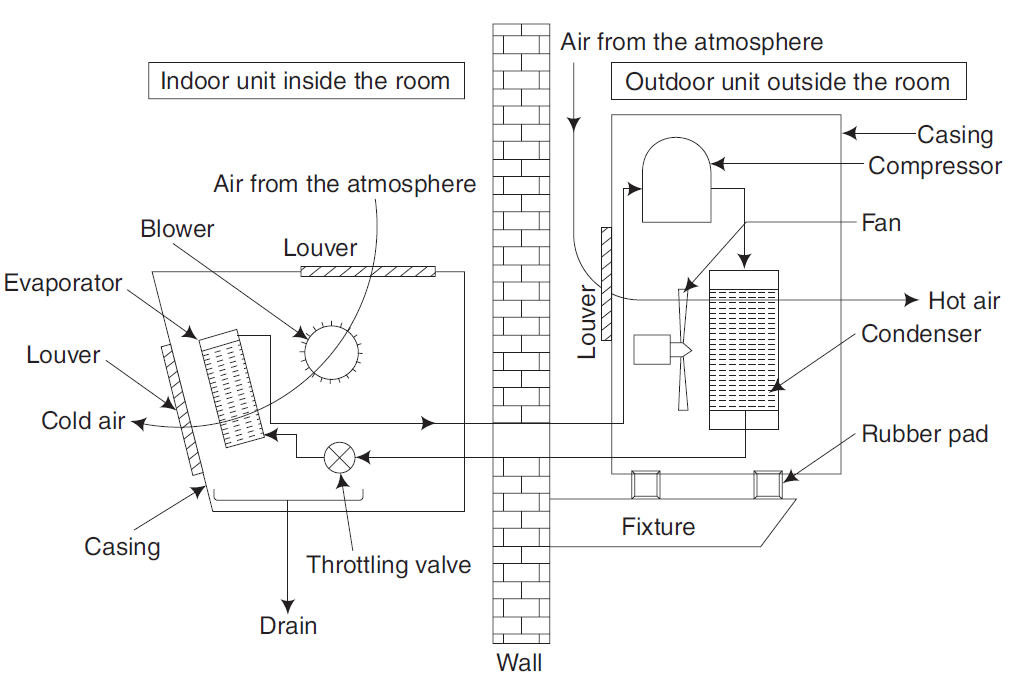A split air conditioner is a type of air conditioning system that consists of two separate units: an indoor unit and an outdoor unit. The indoor unit is responsible for cooling and distributing air, while the outdoor unit houses the compressor and other essential components for heat exchange. These systems provide efficient cooling, are quieter than window ACs, and are commonly used in residential and commercial buildings.
Parts of a Split Air Conditioner

Indoor Unit
- Evaporator Coil – Absorbs heat from the indoor air.
- Blower/Fan – Distributes cool air into the room.
- Air Filter – Traps dust and pollutants.
- Louver – Directs airflow.
- Drain Pipe – Removes condensed water.
Outdoor Unit
- Compressor – Pressurizes and circulates the refrigerant.
- Condenser Coil – Releases absorbed heat to the outside air.
- Fan – Helps dissipate heat efficiently.
- Expansion Valve – Reduces refrigerant pressure before entering the evaporator.
Working Principle of Split Air Conditioners
The working of a split air conditioner is based on the refrigeration cycle, which involves the circulation of a refrigerant between the indoor and outdoor units to absorb heat from the indoor air and release it outside. The steps involved are:
- Compression – The compressor in the outdoor unit compresses the refrigerant, increasing its pressure and temperature.
- Condensation – The high-pressure refrigerant flows through the condenser coils, where it releases heat to the outside air and converts into a high-pressure liquid.
- Expansion – The liquid refrigerant passes through the expansion valve, where its pressure and temperature drop.
- Evaporation – The refrigerant absorbs heat from the indoor air as it passes through the evaporator coils, cooling the air before being circulated back into the room.
- Repeat Cycle – The process repeats continuously, maintaining a cool indoor environment.
Types of Split Air Conditioners
| Type | Description |
|---|---|
| Wall-Mounted Split AC | Most common type, mounted on walls. |
| Cassette AC | Installed in ceilings, suitable for large spaces. |
| Floor-Mounted Split AC | Placed at floor level, ideal for spaces with wall constraints. |
| Ceiling Suspended AC | Used in commercial spaces for high cooling efficiency. |
| Multi-Split AC | Connects multiple indoor units to a single outdoor unit, suitable for multi-room cooling. |
| Inverter Split AC | Uses inverter technology for energy efficiency and consistent cooling. |
Advantages of Split Air Conditioners
- Energy Efficient – Consumes less power compared to window ACs.
- Quieter Operation – Indoor unit operates silently.
- Better Aesthetic Appeal – Modern and sleek designs blend with interiors.
- Flexible Installation – Does not require a window for installation.
- Improved Air Quality – Comes with filters for cleaner indoor air.
- Zonal Cooling – Provides precise cooling to different rooms.
Applications of Split Air Conditioners
- Residential Homes – Bedrooms, living rooms, and apartments.
- Commercial Buildings – Offices, conference rooms, and malls.
- Hotels and Restaurants – For enhanced customer comfort.
- Hospitals and Clinics – Maintaining optimal temperature and air quality.
- Educational Institutions – Classrooms, libraries, and auditoriums.
Disadvantages of Split Air Conditioners
- Higher Initial Cost – More expensive than window ACs.
- Complex Installation – Requires professional installation with piping and wiring.
- Outdoor Space Requirement – Needs space for the outdoor unit.
- Maintenance – Regular servicing is needed for optimal performance.
Conclusion
Split air conditioners provide an efficient and comfortable cooling solution for various applications. With advanced features, energy efficiency, and aesthetic appeal, they have become a preferred choice over traditional air conditioning systems. However, installation complexity and cost considerations should be factored in before making a purchase decision.
